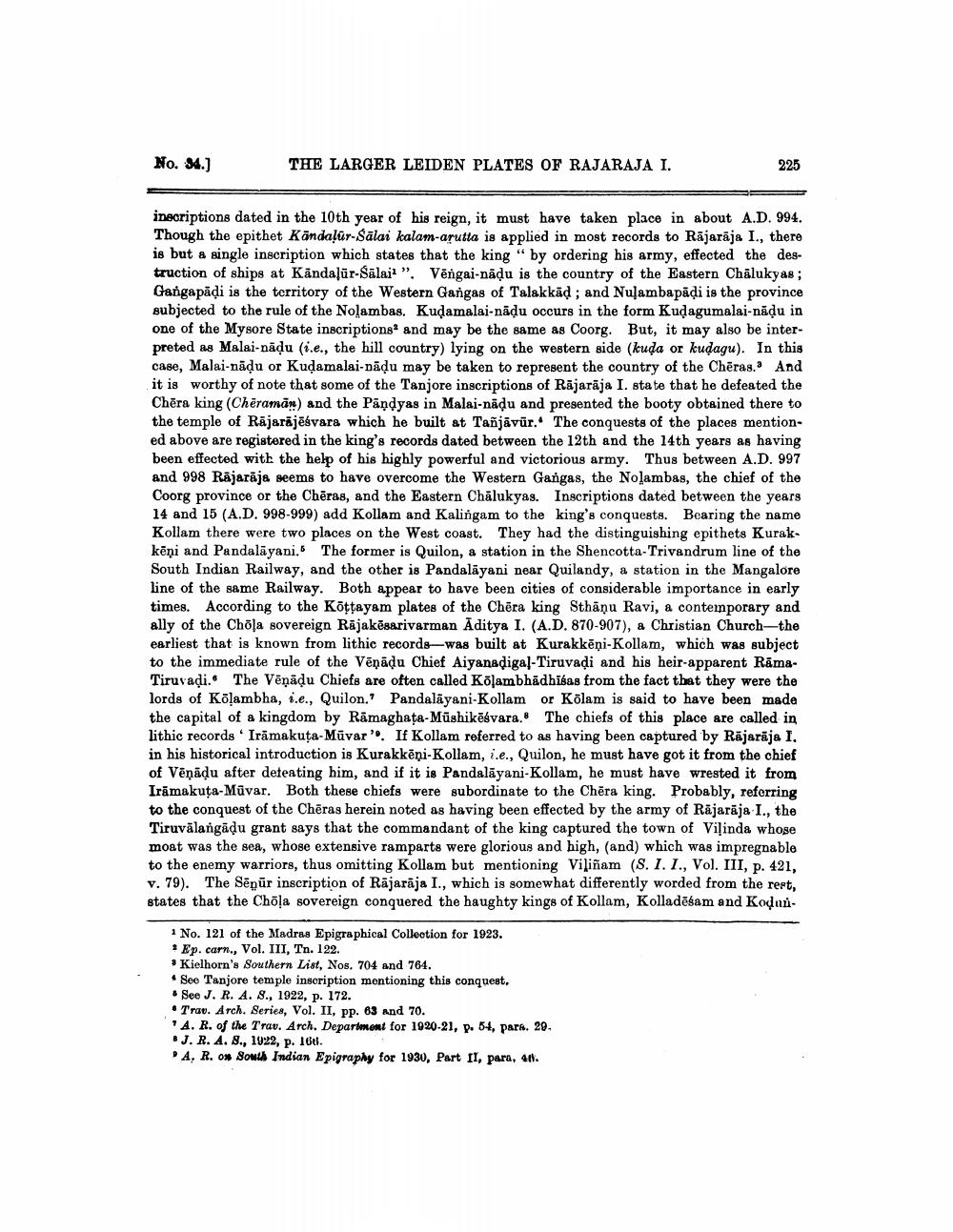________________
No. 84.]
THE LARGER LEIDEN PLATES OF RAJARAJA I.
225
inscriptions dated in the 10th year of his reign, it must have taken place in about A.D. 994. Though the epithet Kāndalur-Salai kalam-arutta is applied in most records to Rājarāja I., there is but a single inscription which states that the king" by ordering his army, effected the destruction of ships at Kandaļūr-Sālaia ". Vēngai-nādu is the country of the Eastern Chalukyas ; Gangapādi is the territory of the Western Gangas of Talakkad ; and Nuļambapādi is the province subjected to the rule of the Nolambas. Kudamalai-nādu occurs in the form Kudagumalai-năļu in one of the Mysore State inscriptions and may be the same as Coorg. But, it may also be interpreted as Malai-nāņu (i.e., the hill country) lying on the western side (kuda or kudagu). In this case, Malai-nādu or Kudamalai-pādu may be taken to represent the country of the Chēras. And it is worthy of note that some of the Tanjore inscriptions of Rājarāja I. state that he defeated the Chēra king (Chēraman) and the Pāņdyas in Malai-nādu and presented the booty obtained there to the temple of Rājarājēsvara which he built at Tañjāvür.. The conquests of the places mentioned above are registered in the king's records dated between the 12th and the 14th years as having been effected with the help of his highly powerful and victorious army. Thus between A.D. 997 and 998 Rājarāja seems to have overcome the Western Gangas, the Nolambas, the chief of the Coorg province or the Chēras, and the Eastern Chalukyas. Inscriptions dated between the years 14 and 15 (A.D. 998-999) add Kollam and Kalingam to the king's conquests. Bearing the name Kollam there were two places on the West coast. They had the distinguishing epithets Kurakkēņi and Pandalāyani. The former is Quilon, a station in the Shencotta-Trivandrum line of the South Indian Railway, and the other is Pandalāyani near Quilandy, a station in the Mangalore line of the same Railway. Both appear to have been cities of considerable importance in early times. According to the Kottayam plates of the Chēra king Sthāņu Ravi, a contemporary and ally of the Chola sovereign Rājakēsarivarman Aditya I. (A.D. 870-907), a Christian Church-the earliest that is known from lithic records—was built at Kurakkēņi-Kollam, which was subject to the immediate rule of the Vēnādu Chief Aiyanadigal-Tiruvadi and his heir-apparent Rāma. Tiruvadi. The Vēņādu Chiefs are often called Kõlambhädbības from the fact that they were the lords of Kõlambha, i.e., Quilon.' Pandalāyani-Kollam or Kõlam is said to have been made the capital of a kingdom by Rāmaghața-Mūshikēšvara. The chiefs of this place are called in lithic records Irāmakuta-Müvar'. If Kollam referred to as having been captured by Rājarāja I, in his historical introduction is Kurakkēni-Kollam, i.e., Quilon, he must have got it from the chief of Vēņādu after deteating him, and if it is Pandalāyani-Kollam, he must have wrested it from Irāmakuţa-Mūvar. Both these chiefs were subordinate to the Chēra king. Probably, referring to the conquest of the Chēras herein noted as having been effected by the army of Rājarāja I., the Tiruvālangādu grant says that the commandant of the king captured the town of Viļinda whose moat was the sea, whose extensive ramparts were glorious and high, (and) which was impregnable to the enemy warriors, thus omitting Kollam but mentioning Viliñam (S. 1. 1., Vol. III, p. 421, v. 79). The Sēpur inscription of Rājarāja I., which is somewhat differently worded from the rest, states that the Chōļa sovereign conquered the haughty kings of Kollam, Kolladēsam and Koduu.
1 No. 121 of the Madras Epigraphical Collection for 1923.
Ep. carn., Vol. III, Tn. 122. • Kielhorn's Southern List, Nos. 704 and 764. • Seo Tanjore temple inscription mentioning this conquest. . See J. R. A. 8., 1922, p. 172. • Trav. Arch. Series, Vol. II, pp. 63 and 70.
A. R. of the Trav. Arch. Department for 1920-21, P. 54, para. 29J. R. A. 8., 1922, p. 10. A, R. # South Indian Epigraphy for 1930, Part II, para, 418.




